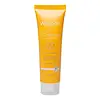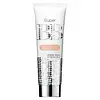Wardah C-defense with Vitamin C DD Cream Versus Physician's Formula Super BB All-in-1 Beauty Balm Cream
What's inside
What's inside
 Key Ingredients
Key Ingredients

 Benefits
Benefits

 Concerns
Concerns

 Ingredients Side-by-side
Ingredients Side-by-side

Water
Skin ConditioningEthylhexyl Methoxycinnamate
UV AbsorberButylene Glycol
HumectantCyclopentasiloxane
EmollientDimethicone Crosspolymer
Emulsion StabilisingCaprylyl Methicone
Skin ConditioningCyclomethicone
EmollientIsododecane
EmollientDisteardimonium Hectorite
StabilisingPropylene Carbonate
SolventPolyglyceryl-4 Isostearate
EmulsifyingCetyl PEG/PPG-10/1 Dimethicone
EmulsifyingHexyl Laurate
EmollientStearic Acid
CleansingSilicon
AbrasiveTitanium Dioxide
Cosmetic ColorantDimethicone
EmollientC30-45 Alkyl Dimethicone
Skin ConditioningTriethylhexanoin
MaskingPolymethyl Methacrylate
Sodium Chloride
MaskingCetyl Dimethicone
EmollientEthylhexyl Palmitate
EmollientNiacinamide
SmoothingPhenoxyethanol
PreservativeEthylhexylglycerin
Skin ConditioningSorbitan Olivate
EmulsifyingBHT
AntioxidantAllantoin
Skin ConditioningAscorbyl Tetraisopalmitate
AntioxidantTocopheryl Acetate
AntioxidantTrimethylsiloxysilicate
EmollientDisodium EDTA
Aluminum Hydroxide
EmollientTriethoxycaprylylsilane
Methicone
EmollientCI 77891
Cosmetic ColorantCI 77492
Cosmetic ColorantCI 77491
Cosmetic ColorantWater, Ethylhexyl Methoxycinnamate, Butylene Glycol, Cyclopentasiloxane, Dimethicone Crosspolymer, Caprylyl Methicone, Cyclomethicone, Isododecane, Disteardimonium Hectorite, Propylene Carbonate, Polyglyceryl-4 Isostearate, Cetyl PEG/PPG-10/1 Dimethicone, Hexyl Laurate, Stearic Acid, Silicon, Titanium Dioxide, Dimethicone, C30-45 Alkyl Dimethicone, Triethylhexanoin, Polymethyl Methacrylate, Sodium Chloride, Cetyl Dimethicone, Ethylhexyl Palmitate, Niacinamide, Phenoxyethanol, Ethylhexylglycerin, Sorbitan Olivate, BHT, Allantoin, Ascorbyl Tetraisopalmitate, Tocopheryl Acetate, Trimethylsiloxysilicate, Disodium EDTA, Aluminum Hydroxide, Triethoxycaprylylsilane, Methicone, CI 77891, CI 77492, CI 77491
Titanium Dioxide
Cosmetic ColorantZinc Oxide
Cosmetic ColorantWater
Skin ConditioningCyclopentasiloxane
EmollientCaprylic/Capric Triglyceride
MaskingNeopentyl Glycol Diheptanoate
EmollientDimethicone
EmollientButylene Glycol
HumectantCetyl PEG/PPG-10/1 Dimethicone
EmulsifyingCetearyl Alcohol
EmollientC30-45 Alkyl Cetearyl Dimethicone Crosspolymer
EmollientPEG-10 Dimethicone
Skin ConditioningSodium Chloride
MaskingGlycerin
HumectantSalix Alba Bark Extract
AstringentButyrospermum Parkii Butter
Skin ConditioningPerilla Ocymoides Seed Oil
Skin ConditioningLysolecithin
EmulsifyingPolysilicone-11
Tetrahexyldecyl Ascorbate
AntioxidantTocopheryl Acetate
AntioxidantDisodium EDTA
Disteardimonium Hectorite
StabilisingGlyceryl Stearate
EmollientLaureth-12
EmulsifyingMagnesium Silicate
AbsorbentMica
Cosmetic ColorantPEG/PPG-18/18 Dimethicone
EmulsifyingPolysorbate 60
EmulsifyingPropylene Carbonate
SolventSodium Hydroxide
BufferingTriethoxycaprylylsilane
Xanthan Gum
EmulsifyingCaprylyl Glycol
EmollientEthylhexylglycerin
Skin ConditioningHexylene Glycol
EmulsifyingPhenoxyethanol
PreservativeTitanium Dioxide, Zinc Oxide, Water, Cyclopentasiloxane, Caprylic/Capric Triglyceride, Neopentyl Glycol Diheptanoate, Dimethicone, Butylene Glycol, Cetyl PEG/PPG-10/1 Dimethicone, Cetearyl Alcohol, C30-45 Alkyl Cetearyl Dimethicone Crosspolymer, PEG-10 Dimethicone, Sodium Chloride, Glycerin, Salix Alba Bark Extract, Butyrospermum Parkii Butter, Perilla Ocymoides Seed Oil, Lysolecithin, Polysilicone-11, Tetrahexyldecyl Ascorbate, Tocopheryl Acetate, Disodium EDTA, Disteardimonium Hectorite, Glyceryl Stearate, Laureth-12, Magnesium Silicate, Mica, PEG/PPG-18/18 Dimethicone, Polysorbate 60, Propylene Carbonate, Sodium Hydroxide, Triethoxycaprylylsilane, Xanthan Gum, Caprylyl Glycol, Ethylhexylglycerin, Hexylene Glycol, Phenoxyethanol
Ingredients Explained
These ingredients are found in both products.
Ingredients higher up in an ingredient list are typically present in a larger amount.
Butylene Glycol (or BG) is used within cosmetic products for a few different reasons:
Overall, Butylene Glycol is a safe and well-rounded ingredient that works well with other ingredients.
Though this ingredient works well with most skin types, some people with sensitive skin may experience a reaction such as allergic rashes, closed comedones, or itchiness.
Learn more about Butylene GlycolThis ingredient is a high molecular weight silicone. It has emulsifying and skin conditioning properties.
Cyclopentasiloxane, or D5, is a silicone used to improve texture of products and trap moisture.
D5 is considered lightweight and volatile. Volatile means it evaporates quickly after application. Once evaporated, D5 leaves a thin barrier that helps keep skin hydrated.
It is also an emollient. Emollients help soften the skin and prevent water loss. Silicones create a silky texture in products. D5 helps other ingredients become more spreadable.
Studies show D5 is safe to use in skincare products. We recommend speaking with a skincare professional if you have concerns.
Learn more about CyclopentasiloxaneDimethicone is a type of synthetic silicone created from natural materials such as quartz.
What it does:
Dimethicone comes in different viscosities:
Depending on the viscosity, dimethicone has different properties.
Ingredients lists don't always show which type is used, so we recommend reaching out to the brand if you have questions about the viscosity.
This ingredient is unlikely to cause irritation because it does not get absorbed into skin. However, people with silicone allergies should be careful about using this ingredient.
Note: Dimethicone may contribute to pilling. This is because it is not oil or water soluble, so pilling may occur when layered with products. When mixed with heavy oils in a formula, the outcome is also quite greasy.
Learn more about DimethiconeDisodium EDTA plays a role in making products more stable by aiding other preservatives.
It is a chelating agent, meaning it neutralizes metal ions that may be found in a product.
Disodium EDTA is a salt of edetic acid and is found to be safe in cosmetic ingredients.
Learn more about Disodium EDTADisteardimonium Hectorite comes from the clay mineral named hectorite. It is used to add thickness to a product.
It can also help stabilize a product by helping to disperse other ingredients.
Hectorite is a rare, white clay mineral.
Learn more about Disteardimonium HectoriteEthylhexylglycerin (we can't pronounce this either) is commonly used as a preservative and skin softener. It is derived from glyceryl.
You might see Ethylhexylglycerin often paired with other preservatives such as phenoxyethanol. Ethylhexylglycerin has been found to increase the effectiveness of these other preservatives.
Phenoxyethanol is a preservative that has germicide, antimicrobial, and aromatic properties. Studies show that phenoxyethanol can prevent microbial growth. By itself, it has a scent that is similar to that of a rose.
It's often used in formulations along with Caprylyl Glycol to preserve the shelf life of products.
This ingredient is a solvent. It helps dissolve active ingredients and alter the texture of products.
Propylene Carbonate is commonly used in makeup and with clay, such as montmorillonite or bentonite.
Studies show this ingredient to be safe for cosmetics. When it is undiluted, it can cause skin irritation. (It is always diluted in skincare and makeup). This ingredient is water-soluble.
Propylene Carbonate is created from propylene glycol and carbonic acid.
Learn more about Propylene CarbonateChances are, you eat sodium chloride every day. Sodium Chloride is also known as table salt.
This ingredient has many purposes in skincare: thickener, emulsifier, and exfoliator.
You'll most likely find this ingredient in cleansers where it is used to create a gel-like texture. As an emulsifier, it also prevents ingredients from separating.
There is much debate on whether this ingredient is comedogenic. The short answer - comedogenic ratings don't tell the whole story. Learn more about comegodenic ratings here.
The concensus about this ingredient causing acne seems to be divided. Research is needed to understand if this ingredient does cause acne.
Scrubs may use salt as the primary exfoliating ingredient.
Learn more about Sodium ChlorideTitanium dioxide is a mineral UV filter widely used in sunscreens and cosmetics.
It is one of only two UV filters officially classified as “mineral” by regulatory agencies, the other being zinc oxide.
Titanium dioxide provides broad-spectrum protection mostly in the UVB and UVAII range, with some protection in the UVAI range.
While its UVA protection isn’t as strong as zinc oxide’s, the difference is minor.
A common myth is that mineral UV filters reflect UV light. However, modern research shows titanium dioxide absorbs UV radiation like chemical filters (~95% absorption & 5% reflection).
Thanks to its non-irritating nature, titanium dioxide is suitable for sensitive, acne-prone, or redness-prone skin. It is unlikely to cause "eye sting" like other sunscreen ingredients.
A major drawback of this ingredient is its white cast and thick texture. This is why mineral sunscreens often leave a white cast and are less cosmetically elegant than chemical/hybrid sunscreens.
To improve white cast and spreadability, micronized or nano-sized titanium dioxide is often used.
There are ongoing concerns surrounding nano-titanium oxide's impact on marine ecosystems.
There is no conclusive evidence that any form of titanium oxide (or any other sunscreen ingredients) will cause harm to marine ecosystems or coral reefs. The science is still developing but many consumers are keeping a close eye on this issue.
Please note, many destinations have reef-safety sunscreen rules. For instance, the U.S. Virgin Islands advises all visitors to use non-nano mineral sunscreens.
Nano mineral sunscreens once raised safety concerns about absorption into skin.
Extensive research has shown that they do not penetrate healthy or damaged skin; they remain safely on the surface and the top layer of dead skin (stratum corneum).
You'll likely find titanium dioxide bundled with alumina, silica, or dimethicone. These ingredients help make titanium dioxide highly photostable; this prevents it from interacting with other formula components under UV light.
Learn more about Titanium DioxideTocopheryl Acetate is AKA Vitamin E. It is an antioxidant and protects your skin from free radicals. Free radicals damage the skin by breaking down collagen.
One study found using Tocopheryl Acetate with Vitamin C decreased the number of sunburned cells.
Tocopheryl Acetate is commonly found in both skincare and dietary supplements.
Learn more about Tocopheryl AcetateTriethoxycaprylylsilane is a silicone used to bind and stabilize ingredients.
As an emulsifier, it helps prevent ingredients from separating. This can help elongate the shelf life of products.
Triethoxycaprylylsilane is often used to coat mineral sunscreens ingredients to help give a better feel. It also helps reduce oxidative stress in sunscreens.
Learn more about TriethoxycaprylylsilaneWater. It's the most common cosmetic ingredient of all. You'll usually see it at the top of ingredient lists, meaning that it makes up the largest part of the product.
So why is it so popular? Water most often acts as a solvent - this means that it helps dissolve other ingredients into the formulation.
You'll also recognize water as that liquid we all need to stay alive. If you see this, drink a glass of water. Stay hydrated!
Learn more about Water